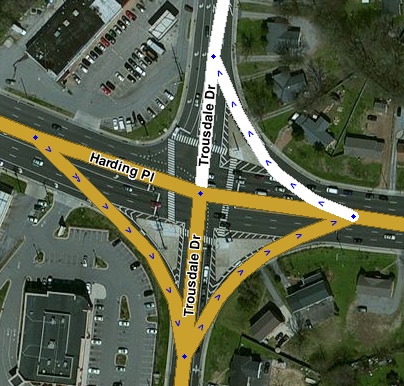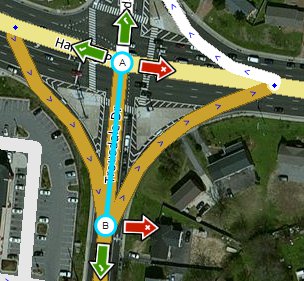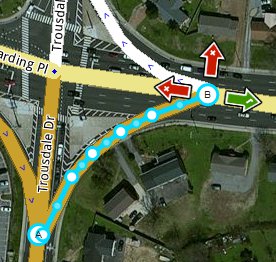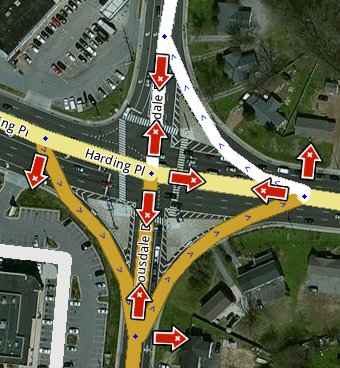No edit summary |
|||
| Line 25: | Line 25: | ||
=== Advance timing of spoken turn alerts === | === Advance timing of spoken turn alerts === | ||
At-Grade Connectors cause turn alerts to be issued earlier. In complex situations, | At-Grade Connectors cause turn alerts to be issued earlier. In most cases the default turn timing is adequate, but in complex situations, advancing the alert may help prevent missed turns. Such situations include: | ||
* highways of three or more lanes in one direction; | * connectors departing from highways of three or more lanes in one direction; | ||
* uncommonly early "commit points" due to extended road striping or physical barriers; or | * uncommonly early "commit points" due to extended road striping or physical barriers; or | ||
* limited visibility of the upcoming intersection | * limited visibility of the upcoming intersection. | ||
Any effort to advance turn-alert timing in complex situations should focus on the penultimate, not final, turn alert. Final turn alerts at complex intersections almost always come too late for drivers who missed the previous alerts, and the community generally does not modify the maps to accommodate those situations. | |||
Waze typically issues penultimate turn alerts at approximately 300 m from the intersection for measured average speeds under 45 mph (minimum 15-second warning), or 800 m for speeds between 45 and 56 mph (minimum 32-second warning). | |||
that the audible was too late, or that the map should have shown a connector | that the audible was too late, or that the map should have shown a connector | ||
Revision as of 04:08, 10 December 2014
When traffic moves between two roads that are at the same grade, these connecting segments are not technically ramps to Waze (unless it falls into one of the Exceptions listed below). When to represent an at-grade connector (AGC) in Waze depends on circumstances.
Applications
As commonly applied in Waze, AGCs serve the following purposes.
Represent a physically separate road corridor
A physically separate, distinct road corridor that connects two larger roads at the same elevation may be represented by an AGC. To qualify for this purpose, the connector must be sufficiently isolated from the roads it connects that typical drivers would expect to see it explicitly depicted on the map, and would be surprised if it were not. Update Requests from users that the map should show a connector always warrant this application.
Prevent incorrect driver locating
Where frontage roads parallel very wide and intersecting highways for an extended distance, AGCs at the intersections may discourage Waze from snapping drivers to the frontage roads. This is uncommon.
Properly route side-road access
Sometimes side roads, especially parking-lot roads, connect near intersections in such a way that the side road can only be accessed from a physically separate right-turn lane. Drivers being routed to the side road must first diverge from the main road, while drivers emerging from the side road can only turn right and then continue along the right-turn path. Such a side road requires joining to an AGC to ensure proper routing.
Prevent "missing road" errors

Tracks that appear to Waze to be "cutting the corner" may cause Waze's automated missing-road detection algorithms to flag a Map Problem. In tests in early 2014, a "corner cutting" path straying as far as 30 m from a junction was not enough to throw this error, but a path straying 65 m was. The actual threshold is unknown, but 50 m may be a good reference. Thus, adding At-Grade Connectors to corner-cuts that come no closer than 50 m to the main roads' intersection junction node is often encouraged. Note that in some cases, such as large bowtie junctions, doing so may result in an excessively cluttered and confused display and it is thought better to omit the At-Grade Connector and tolerate the occasional missing-road Map Problem.
Advance timing of spoken turn alerts
At-Grade Connectors cause turn alerts to be issued earlier. In most cases the default turn timing is adequate, but in complex situations, advancing the alert may help prevent missed turns. Such situations include:
- connectors departing from highways of three or more lanes in one direction;
- uncommonly early "commit points" due to extended road striping or physical barriers; or
- limited visibility of the upcoming intersection.
Any effort to advance turn-alert timing in complex situations should focus on the penultimate, not final, turn alert. Final turn alerts at complex intersections almost always come too late for drivers who missed the previous alerts, and the community generally does not modify the maps to accommodate those situations.
Waze typically issues penultimate turn alerts at approximately 300 m from the intersection for measured average speeds under 45 mph (minimum 15-second warning), or 800 m for speeds between 45 and 56 mph (minimum 32-second warning).
that the audible was too late, or that the map should have shown a connector
Should the connector be mapped?
First and foremost, the need to have the connector mapped needs to be established. As the driver approaches an intersection, Waze has usually given at least one warning that a turn is imminent, and we can assume that the driver is already looking for turn lanes. For most intersections, that is enough to guide the driver into the proper lane and to turn at the proper time; in other words, it is enough that the two roads intersect without separately mapped turning lanes.
When in doubt, leave it out. Each connector complicates the map and adds to your workload when the time comes to check connectivity, direction, name, etc.
Road type
Although sometimes referred to as ramps, to Waze these are not ramps. Ramps in Waze should only be used for situations where two roadways have a grade separated intersection or if the situation matches one of the Exceptions listed below.
The connector segment's type should be set based on the lowest of the types of roads it connects.
- Ex: Street to Minor Highway should be Street type.
- Ex: Minor Highway to Primary Street should be Primary Street type.
- Ex: Primary Street to Primary Street should be Primary Street type.
Example:
Also note how the top-left quadrant of the intersection does not have a connector mapped because it does not meet the requirement of being significantly separated from the main intersection.
Road name
In most cases, leaving the segment unnamed will be sufficient. Navigation instructions will simply use the name of the segment to which the connector segment connects.
If there are specific signs at the intersection which are confusing or contrary to the destination road segment name, then a name can be applied to the connector.
Geometry
The Junction Style Guide provides significant information on how to best set the geometry of the connector to get the best routing and text-to-speech result. Be sure to review that article when updating or creating these connectors.
Turn restrictions
Connectors, if simply added to the map and all turns allowed, would cause significant routing challenges, especially between two 2-way roads. Split roadways have their own challenges, but turn restrictions, due to the 1-way nature of the main segments, are simpler.
In the US, a simple right-turn connector between two 2-way streets, requires that the right turn be restricted at both the primary intersection, and at the connector itself so Waze will not be allowed to tell the driver to turn left across the road to get onto the connector.
AND, at the end of the connector, the left turn must be restricted:
If you enable the "show all restricted connectivity arrows" function in the editor at this intersection, you can see there are many restricted turns. This is sometimes a target for someone looking to remove all restricted turns by abusing the use of the 'w' or Allow All turns function:
Exceptions
| This revision of a section is currently undergoing modifications. The information presented should be considered a draft, not yet ready for use. Content is being prepared by one or more users. Do not make any changes before you post a message in this forum. |
Median U turn intersection (MUTI)

The median crossing segments in a median U turn (aka "Michigan left") intersection should be set to the Ramp type.
Restricted crossing U turn (RCUT) intersection

The median crossing segments in a restricted crossing U turn (aka "J turn" or "Superstreet") intersection should be set to the Ramp type.
Displaced left turn (DLT) intersection

The crossover left turn lanes and the resultant elongated right turn lanes in a displaced left turn (or "continuous flow") intersection should be set to the Ramp type.
Jughandle

Jughandle segments should be set to the Ramp type.
Signed, numbered exit

Example: Garden State Parkway Exit 10 in Cape May Court House, New Jersey, USA. The Garden State Parkway is mostly a freeway class toll-road that runs north/south through New Jersey. As the Parkway approaches its southern terminus, the number of lanes reduce and exits become a mix of grade separated ramps and at-grade intersections. In order to receive an instruction for Exit Right rather than Keep Right or Turn Right, this connector needs to be a ramp.

|

|
Going north, the right turn lane is signed as Exit 10B and the left turn lane is signed as Exit 10A (and reversed going south). |



